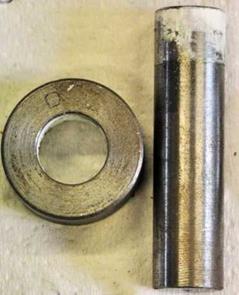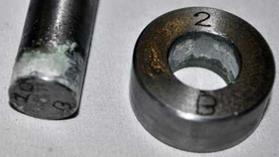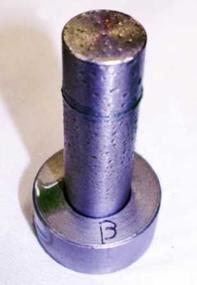The results are collected in the following tables: Table 3 refers to slip fit couplings assembled at R. T.; Table 4 refers to slip fit couplings with collars heated at +180°C; and Table 5 refers to slip fit couplings with pins cooled at — 20°C. Referring to Table 3, the mean adhesive shear strength of slip fit couplings assembled at R. T. can be calculated. Assuming A=446.33 mm2, Eq. (1) gives xad_cle= 38:5 MPa (standard deviation 3.4 MPa), which is greater than the minimum indicated by the manufacturer in the product data-sheet (xad_min= 25 MPa). A picture of the pushed out specimens is given in Figure 2: the polymerised adhesive residue is clearly visible on both the mating surfaces, indicating the expected cohesive failure mode.
|
Figure 2. Slip fit coupling assembled at R. T. |
Slip fits performed by heating the collars at +180°C produced the results reported in Table 4; the mean adhesive shear strength is here equal to 19.5 MPa (standard deviation 4.3 MPa), which is lower than the minimum suggested by the data sheet of the adhesive. This occurrence can be explained by a certain amount of rust observed on the collar coupling surface, due to heating. Rust is, for anaerobic products, an inert substrate which inhibits the complete polymerization of the adhesive and, therefore, reduces the adhesive performances. Figure 3 shows a cohesive failure mode, while some rust spots are visible on the annular surface of the collar.
|
Figure 3. Slip fit coupling assembled after heating the collar at +180°C. |
|
Figure 4. Slip fit coupling assembled after cooling the pin at -20°C. |
Slip fits performed by cooling the pins at -20°C produced the results reported in Table 5; the mean adhesive shear strength drops down to 5.7 MPa (standard deviation 1.8 MPa), which is less than one fourth of the minimum suggested by the data sheet. That outcome can be explained by a large presence of moisture on the pin surface during assembly. In fact, the frost present on the pin as extracted from the freezer, transforms into moisture in a short time at R. T. (20°C). This contamination, well highlighted in Figure 4, drastically inhibits polymerization, reducing the adhesive shear strength.
|
Table 3. Results for pin-collar specimens assembled with clearance at R. T.
|
|
Table 4. Results for pin-collar specimens assembled with clearance and heating the hub
|
|
Table 5. Results for pin-collar specimens assembled with clearance and cooling the shaft
|
 6 сентября, 2015
6 сентября, 2015  Pokraskin
Pokraskin 


 Опубликовано в рубрике
Опубликовано в рубрике 